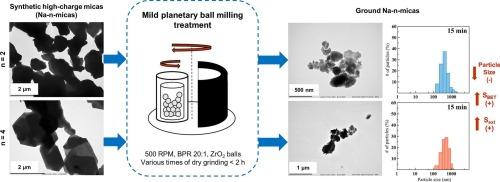机械活化对合成高电荷云母的结构、形态和质地的影响
IF 5.8
2区 地球科学
Q2 CHEMISTRY, PHYSICAL
引用次数: 0
摘要
干磨是机械活化粘土矿物以提高其在各种材料应用中的效率的一种有效方法。这是通过增加暴露的活性位点的数量和通过减小颗粒尺寸的总表面积来实现的。然而,这种方法经常导致结晶度的降低或粘土材料结构的改变。在这种情况下,高铝含量的三八面体粘土表现出更大的结构抗降解能力。因此,本工作旨在采用干磨作为一种有效的自上而下纳米烧结方法,从高电荷云母族中获得纳米粘土。高电荷云母是一种在四面体层中含有铝的三八面体合成云母,由于其有趣的吸附特性而被广泛研究。这项工作的新颖之处在于证明干磨可以有效地将高电荷云母的粒径减小到纳米级,同时保持其结构完整性,这代表了三八面体粘土在不诱导非晶化的受控机械活化方面的重大进展。为了减少非晶化的风险,使用行星球磨机进行温和的铣削条件。在500转/分钟的转速下研磨15分钟后,颗粒尺寸从微米级大幅减小到纳米级,同时保留了材料的长程和短程顺序。此外,尽管长时间研磨,云母的外表面积仍然明显增加,而其特有的结构性质保持不变。以天然粘土矿物蒙脱土为参考,比较了同等磨矿条件下蒙脱土的结构和织构性能。本文章由计算机程序翻译,如有差异,请以英文原文为准。

Effect of mechanical activation on the structural, morphological and textural properties of synthetic high-charge micas
Dry grinding is an effective method for mechanically activating clay minerals to enhance their efficiency in various material applications. This is achieved by increasing the number of exposed active sites and the overall surface area through particle size reduction. Nevertheless, this method frequently results in a reduction of crystallinity or alterations in the structure of the clay material. In this context, trioctahedral clays with a high aluminum content exhibit greater structural resistance to degradation. Thus, this work aimed to employ dry grinding as an effective top-down nano-sintering method to obtain nano-clays from the high-charge mica family. High-charge micas are a group of trioctahedral synthetic micas with aluminum in the tetrahedral layer, widely studied because of their interesting adsorption properties. The novelty of this work laid in demonstrating that dry grinding can effectively reduce the particle size of high-charge micas to the nanoscale while preserving their structural integrity, representing a significant advancement in the controlled mechanical activation of trioctahedral clays without inducing amorphization. To reduce the risk of amorphization, gentle milling conditions were applied using a planetary ball mill. After 15 min of grinding at 500 rpm, a substantial reduction in particle size from microns to the nanoscale was obtained, while preserving the long and short-range order of the material. Moreover, despite prolonged grinding, an increase in external surface area was still evident, while the characteristic structural properties of micas remained intact. Montmorillonite, a natural clay mineral, was used as a reference for comparing the structural and textural properties under equivalent grinding conditions.
求助全文
通过发布文献求助,成功后即可免费获取论文全文。
去求助
来源期刊

Applied Clay Science
地学-矿物学
CiteScore
10.30
自引率
10.70%
发文量
289
审稿时长
39 days
期刊介绍:
Applied Clay Science aims to be an international journal attracting high quality scientific papers on clays and clay minerals, including research papers, reviews, and technical notes. The journal covers typical subjects of Fundamental and Applied Clay Science such as:
• Synthesis and purification
• Structural, crystallographic and mineralogical properties of clays and clay minerals
• Thermal properties of clays and clay minerals
• Physico-chemical properties including i) surface and interface properties; ii) thermodynamic properties; iii) mechanical properties
• Interaction with water, with polar and apolar molecules
• Colloidal properties and rheology
• Adsorption, Intercalation, Ionic exchange
• Genesis and deposits of clay minerals
• Geology and geochemistry of clays
• Modification of clays and clay minerals properties by thermal and physical treatments
• Modification by chemical treatments with organic and inorganic molecules(organoclays, pillared clays)
• Modification by biological microorganisms. etc...
 求助内容:
求助内容: 应助结果提醒方式:
应助结果提醒方式:


